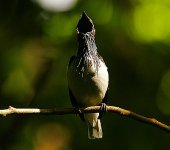Hello,
I've got more of a 'locations associated with a species' question than a 'species associated with a location' one, but I figured this would be the most appropriate place to post.
I'm a graduate student at Cornell and am beginning work on vocal communication and learning in the bearded bellbird (Procnias averano). I'm in the process of looking for possible field sites and could use help finding an appropriate one in either Trinidad, Venezuela, or Guyana.
I am already aware of the population near the Asa Wright center in Trinidad, but could use some advice from anyone familiar with other large populations (i.e. not scattered individuals) of these birds. Ideally, the site would be close enough to a research station or town that daily travel to the leks would be feasible.
Any advice you could provide (either about potential field sites or contacts who might have relevant information) would be very much appreciated. And if you are concerned about what I'd be doing out there, this will be a primarily observational (non-invasive) study.
Thanks in advance!
I've got more of a 'locations associated with a species' question than a 'species associated with a location' one, but I figured this would be the most appropriate place to post.
I'm a graduate student at Cornell and am beginning work on vocal communication and learning in the bearded bellbird (Procnias averano). I'm in the process of looking for possible field sites and could use help finding an appropriate one in either Trinidad, Venezuela, or Guyana.
I am already aware of the population near the Asa Wright center in Trinidad, but could use some advice from anyone familiar with other large populations (i.e. not scattered individuals) of these birds. Ideally, the site would be close enough to a research station or town that daily travel to the leks would be feasible.
Any advice you could provide (either about potential field sites or contacts who might have relevant information) would be very much appreciated. And if you are concerned about what I'd be doing out there, this will be a primarily observational (non-invasive) study.
Thanks in advance!






